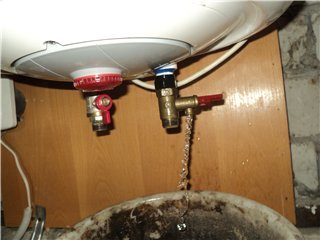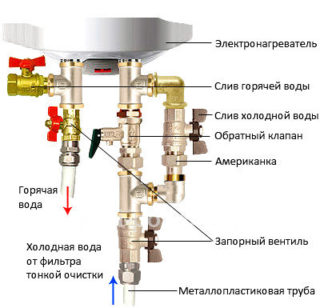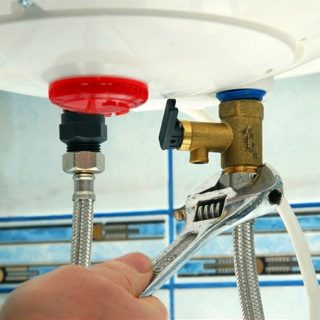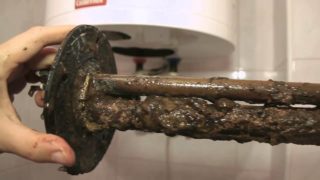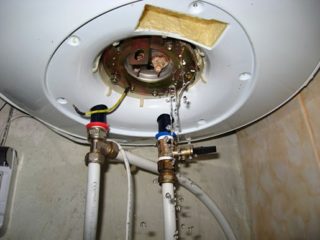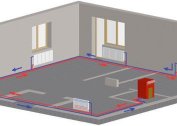For the boiler to last a long time, it needs to be cleaned from time to time. To do this, completely drain the water heater. Also, the tank is emptied in case of seasonal use, repair work. If you figure out how to properly drain the water from the boiler, you do not have to spend a lot of time on it.
Reasons to flush
The need for discharge depends on the operating mode, the contamination of the tank, its design features.
Reasons for draining the water heater:
- Seasonal use, for example, in the country. With the advent of winter colds, the liquid can freeze and “tear” the internal storage capacity.
- An accident on the water main or interruptions with centralized water supply. Drained water can be used for domestic purposes or pour it into the toilet bowl.
- The need for cleaning and repair. Drain is inevitable if it is necessary to clean the tank and the heater from scale, replace the magnesium anode, and fix the breakdown of the electric heater.
For the unit standing in a room with heating, it is not necessary to drain the liquid for a period of absence of owners. But it is necessary to take into account the design features of the water heater. There will be no problems with the capacity of the stainless steel, and for copper heating elements the liquid inside is dangerous. The destruction of this metal in hard water occurs faster than in air saturated with moisture.
If the fluid for the heating device is drawn from the central water system, it will not foul for a long time due to the disinfecting components. Well water flows without bleach. Therefore, the risk of developing bacteria and stagnant odor is higher. To avoid this, empty the container.
Heater drainage procedure
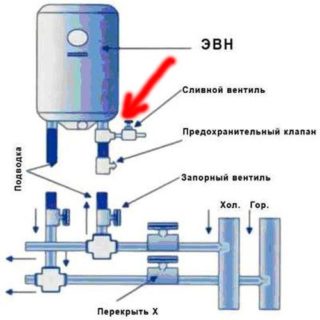
If you decide to empty the tank, you can do this only after the contents have cooled to room temperature. With a closed water supply system and the opening of a hot tap, at most a liter and a half will pour out of the tank, everything else will remain inside. To understand why this happens, and then properly drain the water, you need to know how the electric heater is arranged:
- Heated water is taken from the upper part of the tank through a special tube, and enters the lower part of the water heater.
- The cold water pipe is connected through a non-return poppet valve, which prevents water from flowing back to the main. He is also responsible for bleeding off the excess pressure that appears when heating and expanding the liquid.
- In the storage type electric heater, water from the tank is supplied under the influence of the pressure of the main cold water pipe.
- If you block the flow of cold water and the system stops working, the liquid from the tank itself will not leak. Only the water that was above the intake pipe will pour out of the mixer.
There is no other way than to drain the water from the boiler through a cold pipe, since it is located at the bottom of the tank. The drainage method is determined depending on the binding of the water heater.
Drain with standard, advanced and simplified connection type
In the standard version, it is much easier to empty the boiler capacity. But in the piping scheme, a drain valve mounted on the tee after the non-return valve is required.
To empty the tank:
- Shut off the cold pipe with a valve, unplug the appliance from the outlet, open the hot water on the mixer.
- Connect a hose of the required length to the drain cock.
- Prepare a bucket or other capacious container.
- Pour contents in parts through an open tap.
There is no need to disconnect the pipes; when filling the drain tank, it is enough to close the valve. The jet from the hose does not hit, because the amount of air entering the tank is limited by the mixer.
An improved version of the standard connection suggests a more convenient drainage procedure, since the tee is mounted on two sides: at the inlet of cold and the outlet of heated water. With this type of strapping, you must first close the valve at the inlet to the unit. After that, the drain hose is put on and the mixer opens to relieve pressure inside the tank and drain the residues in the outlet pipe. The free end is sent to the sewer or prepared tank and open the shutoff valves for air on the tee of the "hot" pipe.
With a simplified connection option, it is necessary to stop the flow of moisture into the electric heater. Then the hot water valve opens to drain the remainder from the connecting pipe. Next, the lever of the non-return valve is transferred to the open position, and the remaining liquid is drained. This is a fairly long process.
An electric heater with a capacity of 80–100 l will be empty in about two hours, and an apparatus of 50 l in an hour. To speed up the procedure, it is necessary to carefully unscrew the hot pipe to supply air to the reservoir, which will push out the water.
Fast and complete emptying
In the event of an emergency, it becomes necessary to quickly drain the liquid. The procedure is as follows:
- Close the cold water valve installed on the supply pipe. If there is no such regulator at the inlet to the tank, the overlap is carried out on the riser.
- Open the tap on the outlet of boiling water from the electric heater to equalize the pressure inside and out. Then close the valve again.
- Substitute a large pan or basin under the boiler and detach the hose that transfers hot water.
- Unscrew tee with relief valve.
After that, the liquid will merge very quickly. It is necessary to ensure that the pelvis does not overflow, otherwise you can flood the neighbors. In the process of changing containers, the air supply to the water tank must be shut off. The process will be easier if the boiler is mounted above the sink, bathtub, toilet bowl.
Before cleaning the inside of the tank or preserving the cottage heater for the winter, it is imperative to drain the residues from the tank. First, most of the liquid is drained by any of the above methods. After this, it is necessary to remove the water that remains at the bottom.
- Remove the decorative panel from the bottom of the boiler, holding it, disconnect the wires leading to the indicator light.
- Disconnect the wires. In order not to confuse everything during assembly, it is better to take a photo of the filling of the boiler before that.
- Slowly unscrew the flange that serves to support the heater. First loosen the nuts, and when excess fluid drains, turn the element completely.
- Remove the heating element and allow the remaining water to drain.
You need to pull out the heater carefully. If it is not in the case, then it is necessarily covered with scale, which interferes with the passage. If you jerk sharply, you can damage an important part. Therefore, take it out slowly, slowly swinging the element to the sides.
General rules for disassembly and flushing
Before descaling, remove and wash the rubber gasket located between the tank and the flange.
After scooping up the sediment with a scoop (it is easy to make it out of a plastic bottle), flush the container:
- Wash the container from the inside of the hose.Pass the fluid in stages so that it can push the sediment from the bottom.
- After washing the inside of the tank, treat with vinegar or lemon solution to remove odor. For this purpose, use a long stick with a rag tip.
- Clean the heater. First, carefully treat the heater manually with a knife or a screwdriver, removing the easily removable coating layer.
- All that could not be removed, remove by soaking the heater in citric acid or a solution of vinegar. To do this, make a hole in the plastic bottle with a slightly larger cross-section than that of the heating element. Pour hot water and add citric acid or add table vinegar. Leave on for 24 hours, sometimes shaking the scale-dissolving composition or pouring fresh. After a day, remove the heating element and remove the softened coating with a spatula made of wood or plastic.
- Carefully inspect the heater and the magnesium anode. If you find even slight signs of damage, install new items.
After draining or subsequent cleaning operations, the device must be assembled in the reverse order and the water started. This is done before inclusion in the power grid to check the device for leaks.
Features of discharge from boilers of various manufacturers
The drainage procedure in electric heaters is identical for most models. But at the same time, methods that allow to drain water from the boiler without problems can vary depending on the design nuances inherent in each device.
Thermex brand electric heaters are emptied through the nozzle. First, the cold water tap is unscrewed, a hose is installed in its place and sent to the sewer. Vertical instruments require additional air supply. To do this, you need to remove the valve from the hot pipe and open the drain cock. In units of horizontal installation, an air plug hidden by a plug is structurally provided. It opens when you need to empty the tank.
Water from Elektrolux brand water heaters is drained through the spout of a non-return valve.
Ariston brand electric heaters are drained in the same way as vertical Termeks, except for the Eureka model. To empty the tank at Ariston, it is necessary to dismantle the valves from the hot and cold pipes, and then remove the built-in mixer. Under the casing, there is an air plug that must be opened.
The manual for each appliance describes how to drain the water. It is better not to depart from the manufacturer's recommendations.
The need to drain the heating device usually occurs during cleaning, repair or seasonal preservation. No need to carry out the procedure. A water heater is a finely tuned device, so frequent draining of the tank will lead to malfunctions in the unit.
